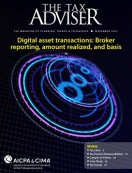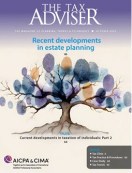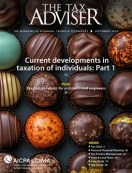- newsletter
- TAX INSIDER

Tax incentives for college students: Part 1
Here’s a comprehensive look at the tax benefits helping with the cost of higher education.
Please note: This item is from our archives and was published in 2020. It is provided for historical reference. The content may be out of date and links may no longer function.
Related
Developing a solid approach to advising clients on Roth IRAs
Taking CARES Act distributions from qualified plans
Recovery rebates: Tax planning pitfalls and opportunities
College is expensive. For students currently enrolled at universities or parents saving for their children to attend, this is known. In fact, the average total price for a four-year degree from a public in-state university is almost $88,000. The price tag for a nonresident to attend an out-of-state university averages $153,300, and it costs almost $200,000 for a private university degree.
Considering the median home price in the United States is $200,000, individuals are spending almost as much on their education as their home. Yet, students enroll in universities every day, investing heavily in their future. Why? For many students, a college degree provides better job opportunities, greater earning potential, and a more secure career. These advantages are worth the cost. The government also has reasons to encourage college enrollment. College graduates are often better off economically than those without degrees.
The government uses the tax law to encourage certain behaviors that it wishes to promote. Education incentives are an intriguing area because it is a rare scenario where Americans are offered tax incentives to do something — in this case, pursue higher education — that people were already inclined to do.
Considering the high cost of education, the government offers various tax credits and deductions to offset the cost. This two-part article looks at the opportunities available at three stages of a fictional student’s life. The first part examines the planning issues when the student is a young child whose parents are saving for college, and as a young adult paying for college. The last part, in next week’s issue, addresses the taxability of scholarships and the issues that arise when the student is a recent graduate paying off student loans.
Saving for college
Coverdell IRAs
B is the child whose life stages we will analyze. As his parents welcome their newest bundle of joy, they begin to plan for his education by saving money using two main savings vehicles: educational IRAs and Sec. 529 plans.
Educational IRAs are also known as Coverdell education savings accounts. These permit a maximum $2,000 contribution to the savings account per year per beneficiary, with no contributions permitted after the beneficiary exceeds 18 years of age (Sec. 530(b)(1)). B‘s parents’ contributions are not tax deductible on their federal income tax return (Form 1040, U.S. Individual Income Tax Return). A number of states offer a deduction on state returns, but it varies by state. As the account balance grows due to the plan’s investments, the increase is not taxable income on the parents’ federal return. If the distribution is used for qualified educational expenses, the distribution is nontaxable. In effect, the earnings are never taxed. For educational IRAs (and Sec. 529 plans), qualified expenses are tuition, fees, books, supplies, travel, and room and board.
The downside of these plans is the low annual contribution limit. Making the maximum contributions of $2,000 every year for 18 years will result in a balance of $36,000 in the account (not including potential earnings) when B enters college. With the high cost of higher education, that will not even cover the first year of school at a private university.
The other downside of these plans is the income phaseouts. For single individuals, the maximum $2,000 contribution begins to be phased out for adjusted gross income (AGI) above $95,000 with taxpayers who are married and filing jointly facing a phaseout when their AGI exceeds $190,000 (Sec. 530(c)).
529 plans: Prepaid tuition
The other category of college savings plans is Sec. 529 plans, also called a qualified tuition program. The two main types are prepaid tuition plans and college savings plans. The prepaid tuition plan is, as its name implies, prepaying for a student’s tuition. B‘s parents could pay for his education now rather than 18 years later when he enters the university. The benefit is based on the time value of money because paying educational costs at present value is less expensive than paying the future value with up to 18 years of inflation.
These plans make sense on a conceptual level, but how does a parent actually prepay for the tuition? People must be residents of a state that offers the program. Many states have several schools under their state umbrella. By purchasing the 529 prepaid tuition from a specific state, the student can attend any school under that state’s umbrella, and the parent can prepay by purchasing course credits or purchasing whole semesters in advance. The plan guarantees that it will grow at a pace that matches tuition increases. Therefore, the purchase of one year’s worth of school now will have earnings through the years that, when B enrolls in school, will be the cost of one year of education regardless of inflation.
The downside with this type of savings plan is obvious. What if B doesn’t want to attend a school in his state? Unless the state in which his plan is located has a reciprocity agreement with another state, B would lose his prepayment. As a contingency, because many students do choose to attend a school outside the state that tuition was prepaid for, the plans can be transferred to another beneficiary (usually a sibling). Many plans will pay an amount equal the state’s average tuition and fees if the beneficiary attends an out-of-state college.
What if B has no other siblings to transfer the 529 plan to and he doesn’t need the prepaid 529 plan because he received a full ride to the university? The Code accounts for this. The earnings portion of the distribution from the 529 plan is taxable, but the 10% penalty for not using the distribution for educational expenses is waived. For example, assume B‘s parents prepaid for three credit hours at a cost of $1,000 and the plan is worth $1,200 years later when B enrolls in college. However, B receives a full scholarship so he withdraws the full $1,200 from the plan. The $200 is taxable and the original $1,000 contribution is a nontaxable return of principal since it was not deducted when contributed. The traditional 10% penalty on earnings for failing to use a Sec. 529 plan for educational expenses is waived because B only was required to include the earnings in income because of his scholarship.
529 plans: College savings
The second type of 529 plan is the college savings plan and is the most popular because of the high contribution limits and no AGI phaseouts. As with the other plans, contributions to the plan are not deducted on the individual’s 1040, and earnings, if used for qualified education expenses, are nontaxable when withdrawn. The federal government has no limit on how much an individual can contribute to the plan as long as contributions do not exceed the expected cost of the degree. Most limits are set at the state level but are exceptionally high — as much as $380,000 can be contributed per year in many states. In addition, there are no income phaseouts.
Taxpayers must be cautious, though. Despite no maximum contribution, contributions to a fund can trigger a gift tax because contributions to a 529 plan are considered gifts. The inflation-adjusted annual gift exclusion for 2020 is $15,000 to any person. Each spouse of a couple filing married filing jointly can give the maximum annual exclusion amount, or one spouse can make a gift up to twice the maximum amount ($30,000) if the couple elects to split the gift. Thus, B‘s parents could contribute $30,000 to the 529 plan and avoid gift tax issues. However, any excess amount would be subject to gift tax rules. In addition, under Sec. 529(c)(2)(B), an individual can “superfund” or “superload” a 529 plan by contributing five years’ worth of gifts ($75,000) in one tax year. However, the individual cannot contribute for the next five years to the fund.
Deductions and credits
After saving for years, B‘s parents are ready for the next phase of his life — college! When a student is actually enrolled in college, the student or taxpayer can take advantage of the tuition and fees deduction and the American opportunity and lifetime learning credits as they pay qualified education expenses
Who usually can claim the deduction and credits? If B‘s parents claim B as their dependent, they can claim a deduction or one of the credits regardless of whether they or B actually paid them. If B cannot be claimed as a dependent, B generally can claim the tuition and fees deduction for the expenses. If B is not claimed as a dependent on any taxpayer’s return (regardless of whether he can be claimed as a dependent by any taxpayer), he generally can claim the American opportunity and lifetime learning credits.
What if B‘s parents can claim him but choose not to? In this case, only B can claim the expenses for purposes of the American opportunity and lifetime learning credits regardless of whether he or his parents paid them. If B‘s parents pay the university for his expenses, it is treated as if B‘s parents gifted the money to B, who turned around and paid the university, and B will be deemed to have paid the tuition himself.
Tuition and fees deduction
The Sec. 222 deduction for tuitions and fees can be claimed on an individual’s tax return as an above-the-line deduction and has not been affected by the temporary elimination of miscellaneous itemized deductions. Students must be enrolled at least part time and seeking a degree. The first $4,000 in educational expenses may be taken as an above-the-line deduction. This deduction can only be used once per tax return, regardless of how many students are enrolled in college and cannot be claimed in conjunction with the American opportunity or lifetime learning credits. (Publication 970, Tax Benefits for Education).
American opportunity credit
The second incentive is the American opportunity credit (AOC), which can be used only during the first four years of a student’s postsecondary education (Sec. 25A(b)(2)). The credit is calculated as 100% of the first $2,000 in educational expenses plus 25% of the next $2,000 in expenses, capping at a $2,500 credit. Therefore, in order to maximize the credit of $2,500, an individual would have to have $4,000 in expenses.
The benefit of the AOC is that you can use it for an unlimited number of qualifying students. Let’s say B and his sister, S, are both enrolled in college during the same year and both are their parents’ dependents. Their parents may claim the AOC for them both, for a maximum credit of $5,000. However, if the parents claim the AOC for the students, they cannot also claim lifetime learning credit for them. This credit is popular because up to 40% of the credit amount can be refundable.
Lifetime learning credit
The third educational incentive is the lifetime learning credit, which is very popular for older students because it can be used beyond the first four years of college and the student does not have to be seeking a degree (Sec. 25A(c)). The credit may be based on qualifying expenses for courses taken to acquire or improve job skills. This credit is $2,000, calculated as 20% of the first $10,000 in expenses. Despite the flexibility of this credit, it can only be used once per return regardless of how many students may qualify for the credit.
Alyssa M. Reed, CPA, M.Acc. (Taxation Concentration), is a staff accountant in the Johnson City, Tenn., tax department of Blackburn, Childers & Steagall, CPAs. She would like to thank Debbie Maney, CPA, for her helpful comments. To comment on this article or to suggest an idea for another article, contact senior editor Sally Schreiber at Sally.Schreiber@aicpa-cima.com.














